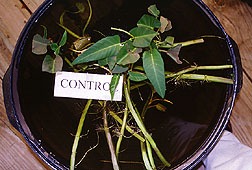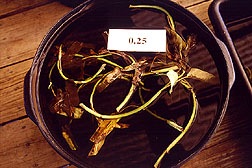Handle This Spinach With Care
|
|
A small Asian plant with an innocent-sounding name has turned itself into the culinary pest of the Florida Everglades.
"Water spinach is a very invasive and aggressive plant," says biologist Robert Kipker, who is with Florida's Department of Environmental Protection (DEP).
"It crowds out native plants and in some countries, damages rice and sugar crops. What's worse, herbicides approved for use in Florida's aquatic environment aren't effective against water spinach."
All the water spinach plants that have been found in Florida's waterways are likely escapees from home gardens or illicit growing plots, according to Kipker.
The first historical record of cultivated water spinach, Ipomoea aquatica, comes from the Chin Dynasty around A.D. 300. Originating in India and Southeast Asia, the plant is rich in iron, making it an ancient remedy for anemia. So people emigrating from those Asian regions understandably wanted to take this nutritious vegetable along for use in traditional recipes.
In the Sunshine State, people grow leftover stems--sometimes purchased illegally--in backyard waterways. If just a little of the rooted plant escapes from the home garden, water spinach can grow explosively. That's what state officials must prevent.
"There are many proposals for keeping this plant from doing what it loves to do best--taking root and spreading," says Kipker. "Freezing or canning it has been suggested, but it's the fresh product people like."
So plant physiologist Thai K. Van, who is with USDA'sAgricultural Research Service, and plant scientist Suzanne Cady, who is with the Hillsborough County Extension Service at the University of Florida, have checked out a different option: irradiation.
They discovered that irradiating water spinach prevents the plant from taking root, should a gardener get the notion to try it. One-half kiloGray is all it takes, according to Van. He works in ARS' Aquatic Weed Research Unit at Fort Lauderdale.
"A kiloGray is a unit of absorbed radiation energy," says Van. "The Food and Drug Administration allows up to 1 kiloGray of irradiation to delay ripening in fruits and vegetables and to control insects, mites, and other pests in food.
The spice industry currently uses irradiation to prevent spoilage of its products. "But," says Kipker, "if we choose the irradiation option, we have to be confident that the plant is not viable."
|
|
Van is completing more tests to confirm earlier results that 100 percent root inhibition occurs at one-half kiloGray. In this study, he will also test the effect of the procedure on flavor quality.
The work could have an even bigger impact, since a change in Florida law is being considered. Under it, private families still couldn't grow water spinach, but farmers with the right expertise would be allowed to grow it for out-of-state sale.
When Florida's DEP found 50 acres of commercial water spinach in production outside of Tampa in 1995, it was seen as time for change. So a new strategy was developed with the help of the state agriculture department. Its goal was to have the crop raised in a tightly quarantined setting by growers who could control it.
Now water spinach growers can obtain a special license after first proving they can grow the crop to state specifications. This means isolating the crop from Everglades tributaries, carefully disposing of plant waste, and surrounding the growing area with a 15-foot buffer zone. Officials from the Florida Department of Agriculture monitor the farms for compliance.
If Van can show his irradiation technique will render the water spinach nonviable, licensed farmers might also be allowed to sell their crop to Florida families one day. There already is an irradiation facility in the state that could conceivably treat the spinach. Then the challenge would be shipping the product safely from the farm to the irradiation plant. --By Jill Lee, Agricultural Research Service Information Staff.
Thai K. Van is in the US DA-ARS Aquatic Weed Research Unit, 3205 College Ave., Fort Lauderdale, FL 33314; phone (954) 475-0541, fax (954) 476-9169.
"Handle This Spinach With Care" was published in the June 1998 issue of Agricultural Research magazine. Click here to see this issue's table of contents








